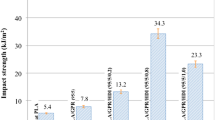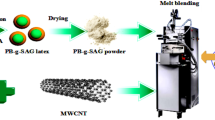Abstract
Coextruded microlayer sheet consisting of alternating layers of polycarbonate (PC) and styrene-acrylonitrile copolymer (SAN) exhibits improved properties such as toughness and ductility as the number of layers is increased. In this study, the composition was kept essentially constant, as was the sheet thickness at 1.2 mm, and the layer thickness was changed by varying the total number of layers from 49 to 776. All the compositions exhibited macroscopic yielding in uniaxial tension but the fracture strain, which represents neck propagation, increased with the number of layers. The increased ductility was attributed to a transition in the microdeformation behaviour observed when microspecimens were stretched in the optical microscope. When the layers were thicker, individual layers exhibited behaviour characteristic of the bulk, that is SAN crazed or cracked while shear bands initiated in PC from the craze tips. As the layer thickness decreased, crazing or cracking of the SAN was suppressed and shear bands that extended through several layers produced shear yielding of both PC and SAN. Calculations showed that when the layer thickness is sufficiently small, impingement of a PC shear band on the interface creates a local shear stress concentration. As a result the shear band continues to grow through the SAN layer and subsequently, at the point of instability, shear yielding can occur in both PC and SAN layers.
Similar content being viewed by others
References
W. J. Shrenk, US Pat. 3884606 (1975).
W. J. Shrenk andT. Alfrey Jr, in “Polymer Blends”, Vol. 1, edited by D. R. Paul and S. Newman (Academic, New York, 1978) Ch. 15, p. 129.
W. J. Shrenk, D. S. Chisholm, K. J. Cleereman andT. Alfrey Jr., US Pat. 3576707 (1971).
J. A. Radford, T. Alfrey Jr andW. J. Shrenk,Polym. Engng. Sci. 13 (1973) 216.
T. Alfrey Jr andW. J. Shrenk, US Pat. 3711176 (1973).
W. J. Shrenk andT. Alfrey Jr,Polym. Engng. Sci. 9 (1969) 393.
J. Im andA. Hiltner, Microlayer Composites in “High Performance Polymers”, edited by E. Baer and A. Moet (Hanser International, Munich, 1990).
B. L. Gregory, A. Siegmann, J. Im, A. Hiltner andE. Baer,J. Mater. Sci. 22 (1987) 532.
J. D. Keitz, J. W. Barlow andD. R. Paul,Appl. Polym. Sci. 29 (1984) 3131.
M. Ma, K. Vijayan, J. Im, A. Hiltner andE. Baer,J. Mater. Sci. 24 (1989) 2687.
K. Matsushige, S. V. Radcliffe andE. Baer,ibid. 10 (1975) 833.
Author information
Authors and Affiliations
Rights and permissions
About this article
Cite this article
Ma, M., Vijayan, K., Hiltner, A. et al. Thickness effects in microlayer composites of polycarbonate and poly(styrene-acrylonitrile). J Mater Sci 25, 2039–2046 (1990). https://doi.org/10.1007/BF01045761
Received:
Accepted:
Issue Date:
DOI: https://doi.org/10.1007/BF01045761




